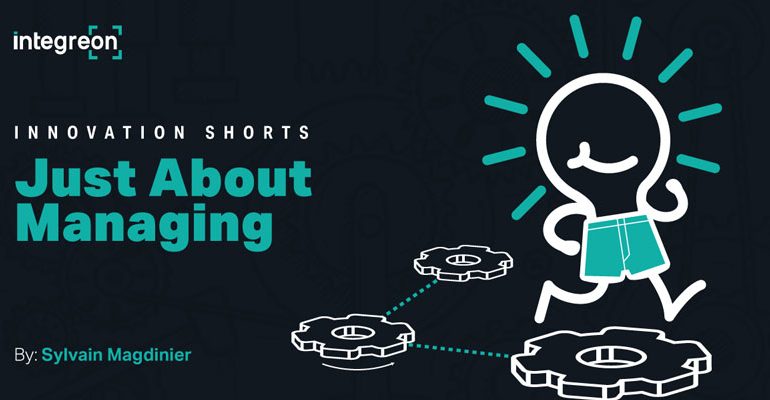Think Differently, Raise Your Game
The managed legal service. For some, a symbol of the NewLaw movement. For others, including in-housers of a nervous disposition, a cynical front for departmental headcount reduction. While for many providers the managed service is nothing less than a solution (= box of tricks), releasing efficiency, technology and innovation into unsuspecting corporate legal operations.
But there is tension at the heart of the managed legal service, even paradox. Two paradoxes, in fact. I decided to investigate these paradoxes, because they go some way to explaining the special characteristics of the contemporary managed legal service. I also decided to talk to an expert in the subject – a bold decision given that I usually look everything up on Wikipedia. I spoke with Reshmi Paul Choudhury for her practical reflections on the challenges and changing features of the managed legal service. Reshmi is an executive in Integreon’s transactions lifecycle services group, with more than 15 years of contracts and legal process experience in this industry. Over the last 5 years she has been leading a key Integreon global account. Reshmi is a proven leader, supporting delivery teams through expanding client accounts, creative innovation programs and unforgiving Karaoke sessions.
Paradox 1: Service that is mechanized but personal
In the context of corporate legal support, mechanization means two things, which should not be confused with each other:
- machine-like service delivery; and
- the use of machines in service delivery.
A feature of managed legal services is that they deploy teams of people who together work like a machine. Think about it. In the old days of law firm practice, clients were given access to lawyers and their skills at an hourly rate. The client paid for expert advice and a quality relationship. Basically, the client paid for time spent by clever people. Or the client paid for people who spent time trying to look clever. One of those two.
But the central proposition of the managed legal service is that the client pays for output, not individuals and their time. The output is measured objectively – i.e. service is delivered against agreed service levels – and those service levels apply regardless of the team members who may come on board or leave from time to time. The service is the same for whoever on the client side is requesting support, and regardless of where the service is being delivered in geographic terms. And the service is delivered at the same price, regardless of the time that may have to be spent on individual matters.
So: machine-like performance, delivered by humans. One way to think about managed legal services, if perhaps not advisable as a marketing slogan.
Then you have the second meaning of mechanization: the increasing use of machines in service delivery. By machines, we mainly mean software, of course, although it would be nice to get your master services agreement redlined while your cappuccino is being dispensed.
Specifically, we are seeing an explosion of client demand for automation within the legal service – the use of software to automate legal operational processes that were previously carried out by people. With the arrival of easy-to-deploy software tools and the adoption of process engineering skills, managed legal service providers are now under increasing pressure to automate all the activities within the processes they touch that are standard, do not involve variable human judgment and which are digital (or capable of being rendered digital in format).
But here comes the paradox: clients never actually ask for “machine-like performance” or “automated performance”, even if that is increasingly what the managed legal service is expected to offer. Clients still want high-quality individuals providing support that is tailored to the client’s operational and cultural requirements. The service still has to feel personal and relationship-driven. You might say that’s a bit unreasonable – like buying a refrigerator and expecting it to rotate the cheese selection automatically according to your mood. Someone please build that, by the way. #cheeseinnovators.
Anyway, unreasonable does not mean impossible. The service has to be capable of giving clients what they want: solutions that are mechanized, but relationship-based. Successful managed legal services achieve that balance through the hard work and skills of the service management team, who provide 3-point operational coverage:
- tracking, interrogating and responding to the data that feed the service level and performance metrics, against which the service is judged;
- coaching the delivery team in client processes, risk tolerances and cultural approach;
- engaging with the client as a partner to understand the operational priorities and business outcomes that are really driving the whole program.
This is where a managed legal service can offer some distinct advantages over a classically constructed in-house legal function. On the metrics side, taking on the burden of data entry and reporting tool management has never been considered a core activity for in-house lawyers. At best, such work is a necessary evil, but it is certainly a distraction from the main task of providing skilled, commercially-focused guidance on legal risk to the business client. By contrast, the service provider is paid to provide specific services that are measured by – and include – SLA reporting. So, to put it bluntly, it is sometimes easier for a service provider’s team manager to get traction with their delivery team when it comes to reporting activity, than it is for an in-house team lead to do the same with their colleagues.
The advantages really boil down to two things: bandwidth and focus. The service provider deploys extra resource, which can help with legal department bandwidth constraints. But just as importantly, the provider is focused on achieving targeted results which are the primary reason for their engagement, lending their activities a degree of concentration that might be more difficult for a busy in-house department juggling a much broader remit.
In highlighting these distinctions, I realize that I am generalizing a little. And one must always be careful with generalizations. But that’s also a generalization, so now I’m just confused. Let’s move on.
The delivery team manager has the task of coaching their team, often providing top-level quality control as well as technical support. And they have the primary task of managing delivery output to the client’s expectations. A good legal service delivery manager has to demonstrate the level of alertness, sensitivity to team dynamics and mastery of timing that you would associate with an orchestral conductor. A bad manager… well, think Mr Bean handling traffic control.
Paradox 2: A world of calm in a sea of change
As we have noted, the managed legal service is expected to deliver machine-like performance: a service that meets the required SLAs day in, day out, across locations and no matter which associates join or leave the service. Consistency and reliability are foundational features of the managed service. Yet a staple ingredient of the proposition these days is continuous improvement. Like it or not, continuous improvement must involve continuous change. How does the service provider square these apparently conflicting demands? In a word, compromise.
In fact, the word is compromises, plural. First of all, there is the trade-off between reactive and proactive change. Clients vary on this, but some have an ambitious agenda for service improvement that requires the service provider to react with considerable agility to their demands. For example, the client may have appointed a managed legal service provider last year, only to decide to implement a contract lifecycle management system this year. Experienced service providers love this sort of reactive challenge because they can bring their expertise and resources to bear on the significant operational demands that such a project will involve. But there is only so much change that a managed service can cope with, so a significant program of this sort will inevitably reduce the service provider’s capacity to design and propose other, more proactive change projects.
Other clients contemplate change at a more measured pace, and look to their service provider to be the engine of creative improvement. It is not enough for the provider to deliver a reliable service using established operating processes and agreed playbooks. Those processes need to evolve and become more efficient – more automated, of course. Playbooks need to expand, cover more areas of business and adapt to changing risk patterns. Some clients want to see a growing presence for technology applications in the service provider’s solutions, almost as a matter of principle. But proactive, provider-led change is not as easy to execute as it may be to sell in an RFP pitch. Three particular challenges stand out:
1. Appetite
Appetite for change, that is, not sandwiches. More specifically, the client needs to have some tolerance for experimentation, even to allow for controlled failures. A true continuous improvement program requires trial and error and a willingness to “give it a go”. Some clients have an overriding concern not to risk disruption to the internal client’s support service, and this mindset can sometimes be a bigger barrier to innovation than the client realizes.
2. Resourcing model
Continuous improvement requires investment. This blindingly obvious statement is sometimes overlooked in practice, both by providers and by clients. The provider may give great PowerPoint on the topic, but when the client takes a closer look at their delivery infrastructure, they realize that the supplier is, as they say in Texas, all hat and no cattle. Innovation within legal process – whether technology is involved or not – requires special skills and capacity.
A slightly more sensitive subject is the level of investment that the client needs to make. There are innovations that a provider can make to its own processes, tech environment and tools, such that the client does not need to be heavily involved in the project. But with managed services, there is usually a degree of interconnectivity between provider systems / processes and those of the client, so that any change on one side cannot be fully implemented without the involvement of the client team. The change program will require client sponsorship, investment of time and a willingness to engage with support functions – IT for example – to drive the project to completion.
3. Commercial model
Continuous improvement has to deliver something meaningful for the client. Year on year price reduction would be nice, but as a business model that requires the provider to acquire new clients at a rapid pace. Tough, says the client – that’s your problem to manage. Fair enough. With the exception of Vladimir Putin’s psychotherapist, the client is always right. But that business model may put the provider’s focus on sales growth in conflict with their existing clients’ expectations of continuing and deepening investment in the installed relationship. There is a better, more sustainable and, in the long run, more valuable commercial model.
We are talking about relative price reduction. Or, to be less cryptic about it, doing more for the same amount of money. Here is a simple illustration:
- Step One: provider identifies various service process elements that can be automated, freeing up full-time equivalent (FTE) resources.
- Step Two: the parties agree the implementation plan and target 3 FTEs as the intended cost saving.
- Step Three: in parallel, the parties agree how the released FTEs will be redeployed – for example, by taking on increased work volumes for the in-scope transactions, or by supporting a new workstream involving previously out-of-scope transactional matters.
- Step Four: plan is implemented.
- Step Five: massive party to celebrate “self-funding continuous improvement”.
This approach delivers meaningful continuous improvement, growing service mechanization and a strengthening relationship between provider and client. Surely an automatic cheese rotator can’t be too much to ask?
More Innovation Shorts to follow. Next time – Unlocking Legal Tech


